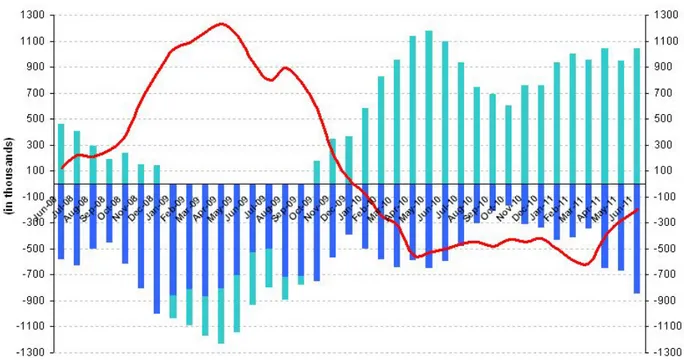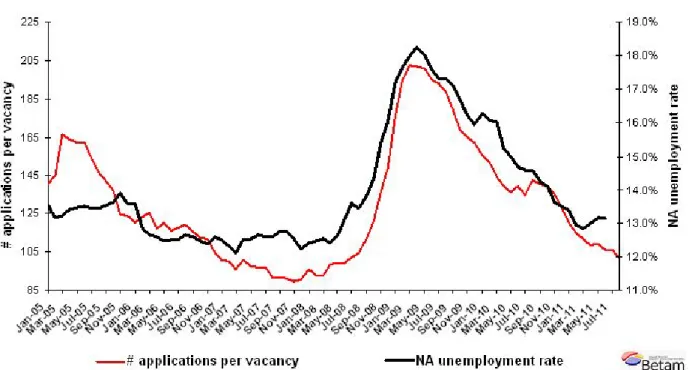NON-AGRICULTURAL UNEMPLOYMENT RATE
HAS NOT BEEN DECREASING
Seyfettin Gursel*, Gokce Uysal∗∗ and Aysenur Acar∗∗∗ Executive Summary
According to the labor market statistics released by TurkStat, non-agricultural unemployment rate came down to 11.9 percent in the period of June 2011. However, seasonally adjusted labor market data shows that non-agricultural unemployment rate remained the same in the period of June 2011 (13.2 percent). According to seasonally adjusted labor market data, increase in service employment (148 thousand) counterbalanced the decline in manufacturing employment. However, strong increase in non-agricultural labor force neutralized the increase in service and construction sector employment, which would have decreased the non-agricultural unemployment rate.
Strong Increase in non-agricultural labor force
According to the labor market statistics released by TurkStat on the 15th of September, employment has
reached 24 million 901 thousand in the period of June 2011 (May – June - July), while non-agricultural employment reached 18 million 301 thousand. Raw labor market statistics reveal that on year-on-year basis, non-agricultural labor force increased by 848 thousand (4.3 percent) and non-agricultural employment increased by 1 million 46 thousand (6.1 percent) in June 2011. On the other hand, non-agricultural unemployment rate decreased from 13.4 percent to 11.9 percent (Figure 1). The salient point is that the increase in non-agricultural labor force has risen to 800 thousand in June 2011. It had reverted back to its trend of 600 thousand in the last three periods.
Figure 1 Year-on-year changes in non-agricultural labor force, employment and unemployment
Source: TurkStat, Betam
*
Prof. Seyfettin Gürsel, Betam, Director, seyfettin.gursel@bahcesehir.edu.tr
∗∗ Assoc. Prof. Gökçe Uysal, Betam, Vice Director, gokce.uysal @bahcesehir.edu.tr ∗∗∗ Aysenur Acar, Betam, Research Assistant, aysenur.acar@bahcesehir.edu.tr
Labor Market Outlook:
September 2011
Seasonally adjusted non-agricultural unemployment remained stagnant
According to seasonally adjusted series, non-agricultural labor force increased by 125 thousand in May compared to its level in May and reached 20 million 677 thousand. The increase in non-agricultural labor force corresponds to 832 thousand people on year-on-year basis. However, non-agricultural employment increased 111 thousand and reached 17 million 957 thousand. Consequently, non-agricultural
unemployment increased only by 42 thousand and non-agricultural unemployment rate remained at 13.2 percent (Figure 2). Non-agricultural unemployment remained stagnant since increase in non-agricultural employment was counterbalanced by a strong increase in non-agricultural labor force.
Figure 2 Seasonally adjusted non-agricultural labor force, employment and unemployment
Source: TurkStat, Betam
According to Kariyer.net data, non-agricultural unemploymentmay decreasein the period of June 20111
The application per vacancy series released by Kariyer.net, which had been remained stagnant in June and July, had a slight decline in August 2011. Given the fact that labor force data will be the average of June – July - August, we expect that seasonally adjusted non-agricultural employment rate may decrease slightly in July 2011.
1
Starting from April, Betam will be using a new series released by Kariyer.net on application per vacancy. Kariyer.net collects this data via their website which is one of the largest job search engines in Turkey. Given the lack of data on vacancies in Turkey, we believe that this new series will provide useful insight to the labor market in Turkey. It provides information on the number of unemployed who are actively seeking work as well as the number of jobs that are available in the labor market. A decrease in applications per vacancy may be caused by an increase in vacancies or by a decrease in the number of applications. An increase in vacancies signals economic growth while decreasing number of applications indicates a decrease in number of people looking for a job. Figure 3 illustrates the seasonally adjusted non-agricultural unemployment rate and deseasonalized calendar day adjusted application per vacancy (Kariyer.net) series. It is clear that these series are highly correlated (almost 90 percent).
Figure 3 Non-agricultural unemployment rate and application per vacancy (SA)
Data source: Kariyer.net, TurkStat, Betam
Increase in service employment in the period of June 2011
According to the seasonally adjusted figures, manufacturing employment decreased by 68 thousand in June 2011 (App. 1 Table 2, App. 2 Figure 4).2 Employment losses in the manufacturing sector during last three periods (April, May, June) are in line with the declines in the industrial production index. Parallel to the increase in the industrial production index in July 2011, we expect an increase in employment in the manufacturing sector in July 2011 as well. Employment in the service sector increased by 148 thousand compared to the previous period and is the main factor behind the increase in non-agricultural
employment.
Seasonally adjusted labor force data shows that agricultural employment, which decreased in the period of April and May 2011, increased 31 thousand in the period of June 2011. The future direction of
agricultural employment still remains uncertain.
2
Seasonal adjustment procedure is applied to each sector of employment series separately. Hence the sum of these series may differ from the seasonally adjusted series of total employment. The difference stems from the non-linearity of the seasonal adjustment process.
Appendix 1: Table 1 Seasonally adjusted non-agricultural labor force indicators (in thousands)
Labor force Employment Unemployment Unemployment rate Monthly changes
May-08 18588 16243 2346 12.6% Labor force Employment Unemployment
June-08 18744 16285 2459 13.1% 156 42 114 July-08 18856 16295 2561 13.6% 112 10 102 August-08 18780 16257 2523 13.4% -77 -38 -38 September-08 18826 16221 2604 13.8% 46 -36 82 October-08 18891 16177 2714 14.4% 65 -44 110 November-08 19011 16083 2928 15.4% 120 -94 214 December-08 19221 16133 3088 16.1% 211 50 160 January-09 19187 15891 3296 17.2% -34 -242 208 February-09 19208 15819 3389 17.6% 21 -72 92 March-09 19286 15817 3469 18.0% 78 -2 80 April-09 19259 15746 3513 18.2% -27 -71 44 May-09 19274 15802 3472 18.0% 15 55 -40 June-09 19271 15883 3388 17.6% -3 82 -85 July-09 19359 16007 3352 17.3% 88 123 -35 August-09 19504 16126 3378 17.3% 145 119 26 September-09 19556 16211 3346 17.1% 52 85 -32 October-09 19655 16376 3280 16.7% 99 165 -66 November-09 19600 16422 3179 16.2% -55 46 -101 December-09 19633 16500 3133 16.0% 33 78 -45 January-10 19692 16485 3207 16.3% 59 -15 74 February-10 19788 16608 3180 16.1% 96 124 -28 March-10 19911 16724 3187 16.0% 123 116 7 April-10 19830 16808 3022 15.2% -81 84 -165 May-10 19896 16916 2980 15.0% 66 108 -42 June-10 19845 16933 2913 14.7% -51 16 -67 July-10 19828 16937 2891 14.6% -18 4 -22 August-10 19808 16918 2890 14.6% -19 -18 -1 September-10 19787 16971 2816 14.2% -21 52 -74 October-10 19844 17042 2802 14.1% 57 71 -14 November-10 19931 17214 2717 13.6% 87 172 -85 December-10 19989 17291 2698 13.5% 58 77 -19 January-11 20134 17437 2697 13.4% 146 146 -1 February-11 20208 17590 2617 13.0% 73 153 -80 March-11 20265 17663 2602 12.8% 58 73 -15 April-11 20470 17811 2659 13.0% 205 148 57 May-11 20552 17845 2707 13.2% 82 34 48 June-11 20677 17957 2720 13.2% 125 111 13
Appendix 1: Table 2 Seasonally adjusted sector of employment (in thousands)
Agriculture Manufacturing Construction Service Monthly changes
May-08 5066 4492 1266 10491 Agriculture Manufacturing Construction Service
June-08 5006 4505 1252 10533 -60 13 -14 42 July-08 4981 4489 1229 10592 -24 -16 -24 59 August-08 5091 4478 1219 10562 110 -12 -9 -31 September-08 5100 4457 1233 10519 8 -21 14 -42 October-08 5188 4395 1244 10516 88 -62 11 -3 November-08 5117 4304 1207 10556 -71 -91 -37 40 December-08 4961 4257 1223 10644 -156 -47 16 88 January-09 4977 4110 1249 10549 16 -147 26 -95 February-09 5008 4079 1257 10492 30 -32 7 -57 March-09 4987 4028 1263 10554 -21 -51 6 62 April-09 5006 3986 1231 10529 20 -42 -32 -25 May-09 5155 3965 1261 10577 148 -21 30 48 June-09 5253 3976 1288 10618 98 11 27 40 July-09 5342 4035 1305 10675 89 59 16 58 August-09 5330 4058 1317 10729 -12 23 13 54 September-09 5408 4126 1317 10725 78 68 0 -4 October-09 5460 4165 1362 10818 52 39 45 94 November-09 5509 4229 1383 10821 49 64 21 3 December-09 5556 4299 1395 10813 47 70 12 -9 January-10 5653 4307 1375 10814 97 9 -20 1 February-10 5629 4357 1367 10900 -24 50 -9 87 March-10 5597 4369 1414 11000 -31 11 47 99 April-10 5668 4410 1444 10993 71 42 30 -6 May-10 5602 4474 1428 11039 -67 64 -16 46 June-10 5711 4523 1429 10991 109 50 1 -48 July-10 5688 4536 1466 10936 -22 13 36 -55 August-10 5694 4493 1424 10947 6 -43 -41 11 September-10 5696 4463 1427 10997 2 -30 3 51 October-10 5823 4458 1448 11059 126 -5 21 62 November-10 5867 4649 1506 11064 45 191 58 5 December-10 5998 4652 1540 11101 131 3 34 37 January-11 6002 4686 1527 11225 3 34 -13 124 February-11 6133 4697 1572 11344 131 12 44 119 March-11 6161 4848 1591 11293 28 151 19 -52 April-11 6074 4836 1637 11396 -87 -12 46 103 May-11 6054 4768 1680 11430 -20 -68 43 34 June-11 6085 4687 1712 11578 31 -81 32 148
Appendix 2: Figure 4 Employment changes in sectors (in thousand)3
Source: TurkStat, Betam
3


